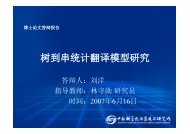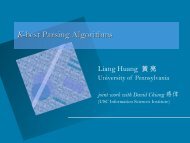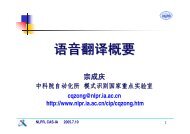Machine Translation with Lattices and Forests
Machine Translation with Lattices and Forests
Machine Translation with Lattices and Forests
Create successful ePaper yourself
Turn your PDF publications into a flip-book with our unique Google optimized e-Paper software.
Code 1 Rule Extraction (Mi <strong>and</strong> Huang, 2008).<br />
Input: lattice-forest F , target sentence τ, <strong>and</strong><br />
alignment a<br />
Output: minimal rule set R<br />
1: fs ← FROSET(F, τ, a) ⊲ frontier set<br />
2: for each v ∈ fs do<br />
3: open ← {〈∅, {v}〉} ⊲ initial queue<br />
4: while open ≠ ∅ do<br />
5: 〈frag,front〉 ← open.pop()<br />
6: if front = ∅ then ⊲ finished?<br />
7: generate a rule r using frag<br />
8: R.append(r)<br />
9: else ⊲ incomplete: further exp<strong>and</strong><br />
10: u ← front.pop() ⊲ exp<strong>and</strong> frontier<br />
11: for each e ∈ IN(u) do<br />
12: f ← front ∪ (tails(e) \ fs)<br />
13: open.append(〈frag ∪ {e},f 〉)<br />
(line 7) . Otherwise we pop one expansion node<br />
u to grow <strong>and</strong> spin-off new fragments by IN(u),<br />
adding new expansion sites (lines 11- 13), until all<br />
active fragments are complete <strong>and</strong> open queue is<br />
empty.<br />
The extra minimal rules extracted on latticeforest<br />
are listed at the right bottom of Figure 5(c).<br />
Compared <strong>with</strong> the forest-only approach, we can<br />
extract smaller <strong>and</strong> more general rules.<br />
After we get all the minimal rules, we compose<br />
two or more minimal rules into composed<br />
rules (Galley et al., 2006), which will be used in<br />
our experiments.<br />
For each rule r extracted, we also assign a fractional<br />
count which is computed by using insideoutside<br />
probabilities:<br />
Q<br />
α(root(r)) · P(lhs(r)) ·<br />
v∈yield(root(r))<br />
c(r) = β(v)<br />
,<br />
β(TOP)<br />
(1)<br />
where root(r) is the root of the rule, lhs(r) is<br />
the left-h<strong>and</strong>-side of rule, rhs(r) is the righth<strong>and</strong>-side<br />
of rule, P(lhs(r)) is the product of<br />
all probabilities of hyperedges involved in lhs(r),<br />
yield(root(r)) is the leave nodes, TOP is the root<br />
node of the forest, α(v) <strong>and</strong> β(v) are outside <strong>and</strong><br />
inside probabilities, respectively.<br />
Then we compute three conditional probabilities<br />
for each rule:<br />
c(r)<br />
P(r | lhs(r)) = ∑<br />
r ′ :lhs(r ′ )=lhs(r) c(r′ )<br />
(2)<br />
c(r)<br />
P(r | rhs(r)) = ∑<br />
r ′ :rhs(r ′ )=rhs(r) c(r′ )<br />
P(r | root(r)) =<br />
(3)<br />
c(r)<br />
∑r ′ :root(r ′ )=root(r) c(r′ ) . (4)<br />
All these probabilities are used in decoding step<br />
(Section 5). For more detail, we refer to the algorithms<br />
of Mi <strong>and</strong> Huang (2008).<br />
5 Decoding <strong>with</strong> Lattice & Forest<br />
Given a source-side lattice-forest F , our decoder<br />
searches for the best derivation d ∗ among the set of<br />
all possible derivation D, each of which converts<br />
a tree in lattice-forest into a target string τ:<br />
d ∗ = argmaxP(d|T) λ0 · e λ 1|d|<br />
d∈D,T ∈F<br />
· LM(τ(d)) λ2 · e λ 3|τ(d)| ,<br />
(5)<br />
where |d| is the penalty term on the number of<br />
rules in a derivation, LM(τ(d)) is the language<br />
model <strong>and</strong> e λ 3|τ(d)| is the length penalty term on<br />
target translation. The P(d|T) decomposes into<br />
the product of rule probabilities P(r), each of<br />
which is decomposed further into<br />
P(d|T) = ∏ r∈dP(r). (6)<br />
Each P(r) in Equation 6 is decomposed further<br />
into the production of five probabilities:<br />
P(r) = P(r|lhs(r)) λ 4<br />
· P(r|rhs(r)) λ 5<br />
· P(r|root(lhs(r)) λ 6<br />
· P lex (lhs(r)|rhs(r)) λ 7<br />
· P lex (rhs(r)|lhs(r)) λ 8<br />
,<br />
(7)<br />
where the last two are the lexical probabilities between<br />
the terminals of lhs(r) <strong>and</strong> rhs(r). All the<br />
weights of those features are tuned by using Minimal<br />
Error Rate Training (Och, 2003).<br />
Following Mi et al. (2008), we first convert the<br />
lattice-forest into lattice translation forest <strong>with</strong> the<br />
conversion algorithm proposed by Mi et al. (2008),









